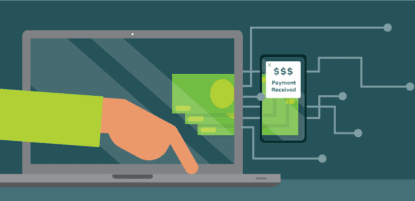In 2023, most B2B payment technology trends will focus on navigating economic uncertainty, cultivating talent, optimizing efficiencies, and embracing digitization. CFOs and finance teams will also use the year ahead to zero in their focus on business process improvements and increasing visibility, particularly in regards to cost and spend analytics. Let’s take a closer look.
1. The Importance of Digital Transformation & Automation
According to The World Bank, the global core inflation rate (excluding energy) could average to about 5 percent in 2023, about twice as high as the five-year average prior to COVID. The World Bank also noted that warning signs for a recession are looming. This has left most finance teams worried about their cash flow for the year ahead.
As a result, teams are looking for ways to increase their efficiency. Many are embracing digital transformation tools as their opportunity to ditch manual tasks (and the inefficient operations, human errors, and unnecessary overhead that come with them). For example, AP teams spend hours each week on the expensive and time consuming tasks of invoice approval routing and payment processing. Meanwhile, 61% of those who have implemented AP automation are able to process more invoices with the same size team, demonstrating the tool’s ability to maximize efficiencies and minimize mistakes along the way. It should come as no surprise then why AP has been the number one digitization priority for finance teams for the last two years running.
Digital transformation efforts also lead many financial teams to adopt electronic payment methods to further improve their AP workflows. 57% of teams note that they expect to save money by adopting electronic payments, while 22% anticipate cash-back rebates and rewards. As economic uncertainties persist, future-proofing the financial function via automation and digital payments will become more important than ever.
2. The Increasing Need for Easy and Fast Global Payments
There has been no shortage of news about real-time payments (RTP) in 2022 with numerous banks and fintechs promoting their support and capabilities. About 90% of business leaders reported interest in RTPs in 2020, with 52% citing they could use RTPs to better manage cash flow. But to date, uptake has not kept pace with the predicted hype.
This is because RTPs can only be as good as the entities willing to pay for them. While some experts predict that RTP will become mainstream, an enhanced payment rail will remain impossible until someone on the buyer or supplier side is willing to take on its added cost. That said, there are several factors that could support the growth of RTP in 2023: vendor relationships continue to be a high priority for businesses struggling with their supply chains; if that trend continues, then some parties may step forward to front the additional costs for RTPs in order to secure necessary goods from their vendors.
3. Continued Focus on Better Data and Analytics
Aside from embracing digitization, finance teams this year will also depend on analytics to improve their operational efficiencies. For example, with the right AP analytics tools in place, teams can better optimize their payment mix to cut costs and improve their decision making abilities.
Simple Mills, a leading provider of better-for-you crackers, cookies, snack bars, and baking mixes, leveraged analytics to investigate important metrics such as spend-by-vendor and then model various business scenarios. “We look at what could happen if we extend payment terms or ask for early-pay discounts with certain suppliers,” said Maddy McGannon, Simple Mills’ Controller. “MineralTree gives us the insight to analyze our payment data and use it to improve business decision making.” This increased visibility and strategic data analysis will be crucial for teams this year.
4. Using Technology to Protect Supply Chains by Prioritizing Vendor Relationships
70.8% of teams noted that their supplier relationships have grown more important over the past year. In healthcare, this number is even higher with 75.3% noting the growing necessity of their vendors. However, businesses across the globe have been negatively impacted by supply chain disruptions due to COVID-19, the invasion of Ukraine, and severe weather.
B2B payment technology can help businesses protect their supply chains through improved vendor relationships. According to McKinsey, companies that had higher degrees of collaboration with their vendors, reported more growth and lower operating costs. This year, expect teams to expand their use of technology to protect their vendor relationships and secure the goods they need to run their business.
Making on-time payments and offering visibility into an often muddled payment process are two quick ways that finance organizations can improve their supplier relationships. With AP automation, finance teams can also easily schedule on-time payments in a supplier’s preferred method, while seamlessly providing updates on the state of payment.
5. Expanded Partnerships Between Financial Institutions and B2B Software Partners
Software companies continue to expand their businesses beyond their original products, as new potential competitors stack up. Without the manpower to build enough new offerings this year to match pace with all the existing B2B software partners, banks must get comfortable partnering with other groups in the B2B space. Else they risk forfeiting valuable opportunities to expand their market reach.
6. New Work Processes Invite New Forms of Payment Fraud
Remote and hybrid environments have made fraud protection even more difficult for businesses. Their new processes have opened up space for communication gaps via email and other digital channels that are advantageous for hackers. Smaller organizations are especially vulnerable as targets, since they typically don’t notice when security has been compromised until it’s too late.
With the influx of invoice payments being made, AP teams will need to rely more heavily on their tools to ensure they are protected from fraudulent activity. More regulations are coming into play to limit the possibility of fraud from occurring the way we know it today but it’s only a matter of time until scammers will evolve their methods. New protections only last for a short amount of time, but the right B2B payment technology partner can help teams more easily identify fake invoices and inconsistent payment information.
Final Thoughts
As organizations head into a new year, digital transformation and automation will be important tools to maintain smooth business operations. Schedule a demo today to learn more about how MineralTree can help your team reduce operational expenses, increase security, and improve cash flow management.




